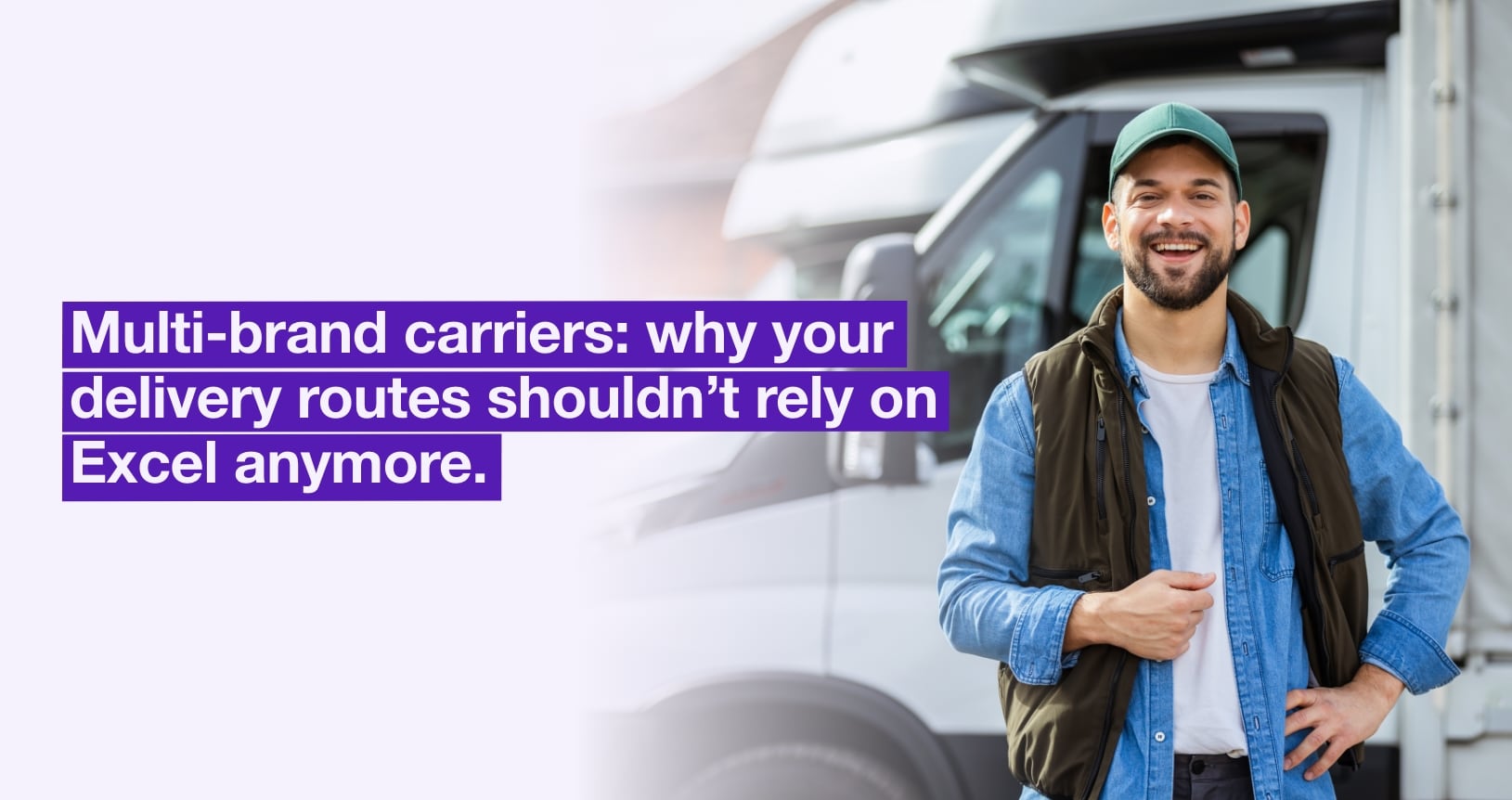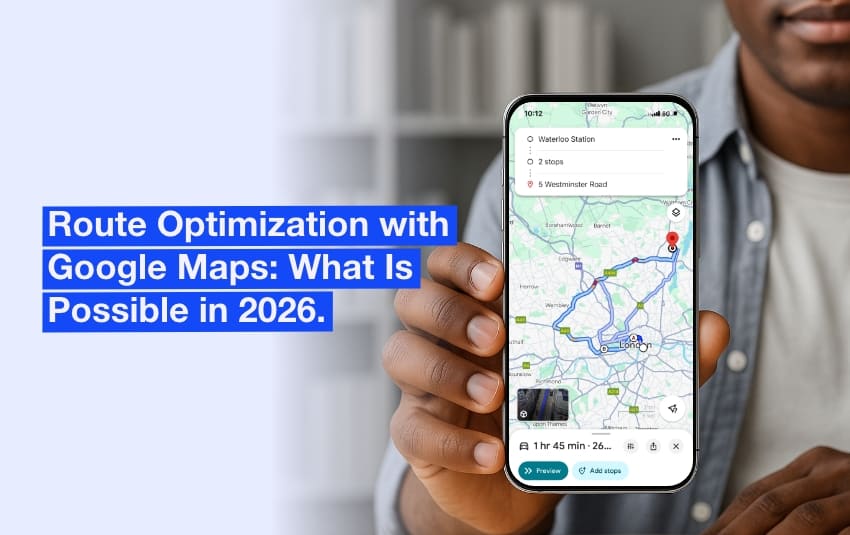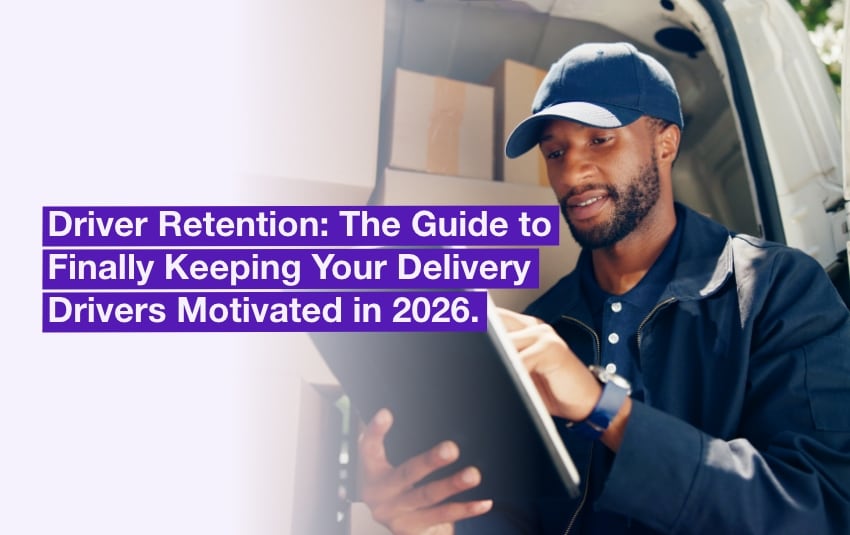Multi-brand carriers: why your delivery routes shouldn’t rely on Excel anymore
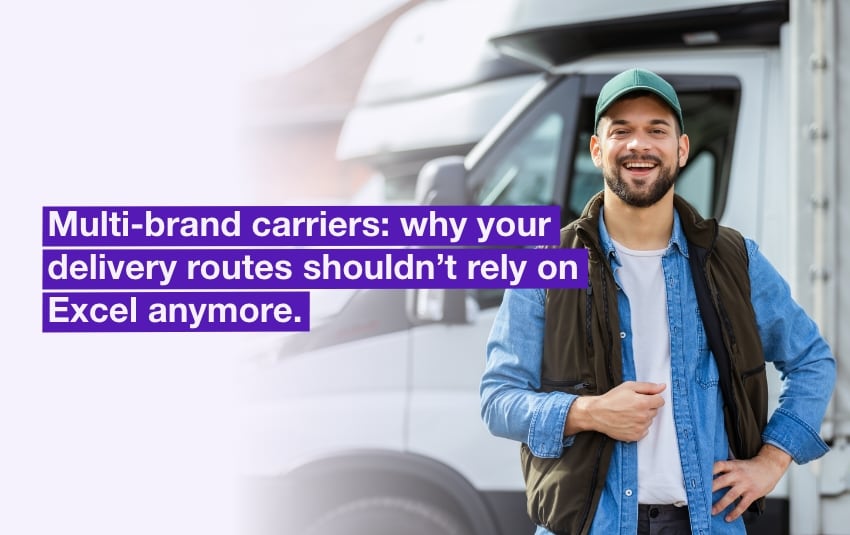
For a long time, Excel reigned supreme over delivery schedules. Convenient, free, and endlessly customizable, it was more than enough to plan a few daily routes. But as operations grow, things quickly get complicated. Files multiply — and so do errors. And when you’re managing several retail chains (DIY, appliances, furniture), each with its own rules, schedules, and warehouses… Excel soon reaches its limits. The result? Longer days, repeated mistakes, and declining performance. Yet many carriers still rely on it, out of habit, or simply out of fear of change.
But times have changed, and efficiency is no longer optional. Automating route planning has now become essential to stay competitive: fewer errors, greater reliability, and more peace of mind for both dispatchers and drivers.
Maybe it’s time to turn the page on Excel. Let’s take a closer look at why, and how, to make the switch with AntsRoute, a platform designed specifically for transport professionals.
Table of contents:
- The promises of Excel (and why they no longer deliver)
- The 4 signs you’ve outgrown spreadsheets
- Automate to regain control of your schedules
- From Excel to a SaaS solution like AntsRoute: a simple and natural transition
The promises of Excel (and why they no longer deliver)
Let’s be honest: Excel has done a great job for thousands of carriers. For years, it was the Swiss army knife of logistics: you could plan, adjust, and check everything in one place. You could build schedules by hand, tweak timings on the fly, and track routes in a simple spreadsheet. It was perfect… until logistics reality caught up with the spreadsheet.
Promise #1: “It’s free and flexible.”
Only on the surface. Behind every cell lies hours of manual data entry, cross-checking, and a high risk of errors. Excel’s hidden cost comes in the form of delays, duplicates, oversights, unnecessary trips, and unhappy customers. It may seem like a short-term financial gain, but it’s a long-term productivity loss.
Promise #2: “I stay in control of my schedules.”
True. But at what cost? With Excel, everything often depends on a single person: the dispatcher. Every change turns into a collective headache: there’s no shared visibility and no real-time tracking. And when a delivery is canceled or a vehicle breaks down, the entire schedule collapses.
Promise #3: “It’s easy to update.”
Yes… until you’re managing multiple retailers, warehouses, and types of services. At that point, the spreadsheet becomes a real minefield. A single formula error can throw off an entire day of deliveries. We’ve all seen that infamous file named “Final_Planning_v4_definitive(3).xlsx.” If you’re smiling right now, you already know it’s time to move on.
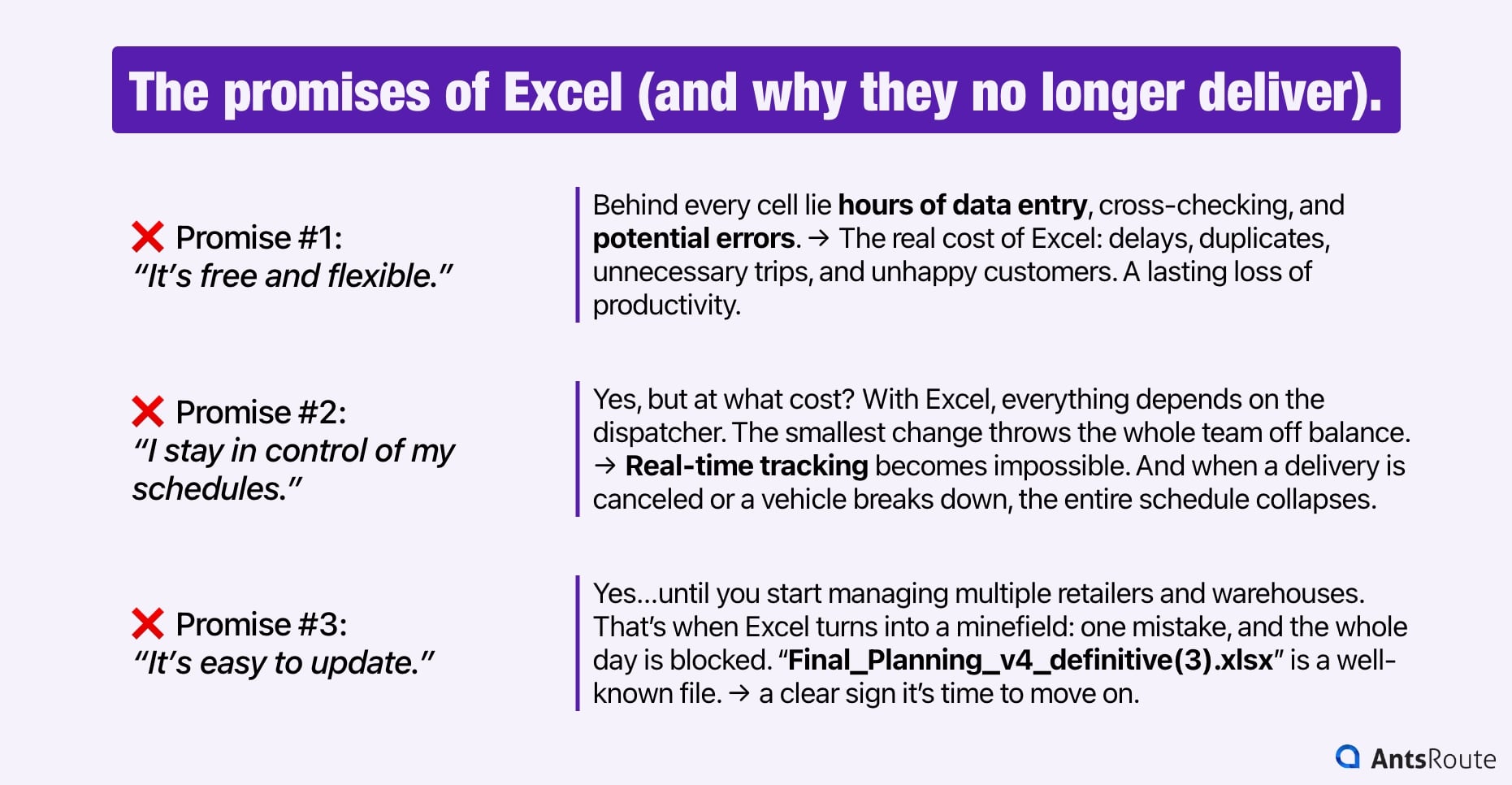
Excel’s promises (and why they no longer deliver).
The 4 signs you’ve outgrown spreadsheets
Still think Excel is enough for you? If you recognize at least two of these signs, it’s probably time to switch to a more suitable tool.
1. You’re juggling ten different files
One for Retailer A, another for Retailer B, a third for Monday’s routes… and no one really knows which one is up to date. As long as your drivers handle a handful of deliveries, it’s fine. But once you start managing dozens of routes, especially across multiple retail chains, things get messy. Tabs pile up, filters multiply, and last-minute changes break your formulas.
2. Human errors are piling up
One misplaced cell, one deleted formula, one wrong copy-paste… and suddenly a driver has two deliveries scheduled at the same time, 40 kilometers apart. These mistakes may look minor on paper, but out in the field, they’re costly: extra mileage, delays, stress, and sometimes penalties from partner retailers. The more your delivery volume grows, the higher the risk of error. Every manual entry is an opportunity to make one.
3. You struggle to react to the unexpected
Delays, absences, last-minute emergencies… With Excel, every change means recalculating everything. Meanwhile, drivers wait, customers get impatient, and costs rise.
“Whenever a driver was running late, we’d spend the whole day on the phone rescheduling the next deliveries.” That’s a story we hear often from carriers who switched to AntsRoute. Today, a single click is all it takes to adjust a route: drivers get real-time updates, and customers automatically receive a notification.
4. You’re flying blind when it comes to costs and margins
Excel can’t automatically calculate the cost of a route or the profitability per customer or retailer. You can’t identify unprofitable trips, unproductive time, or performance gaps between drivers. You’re managing by instinct, not by data.
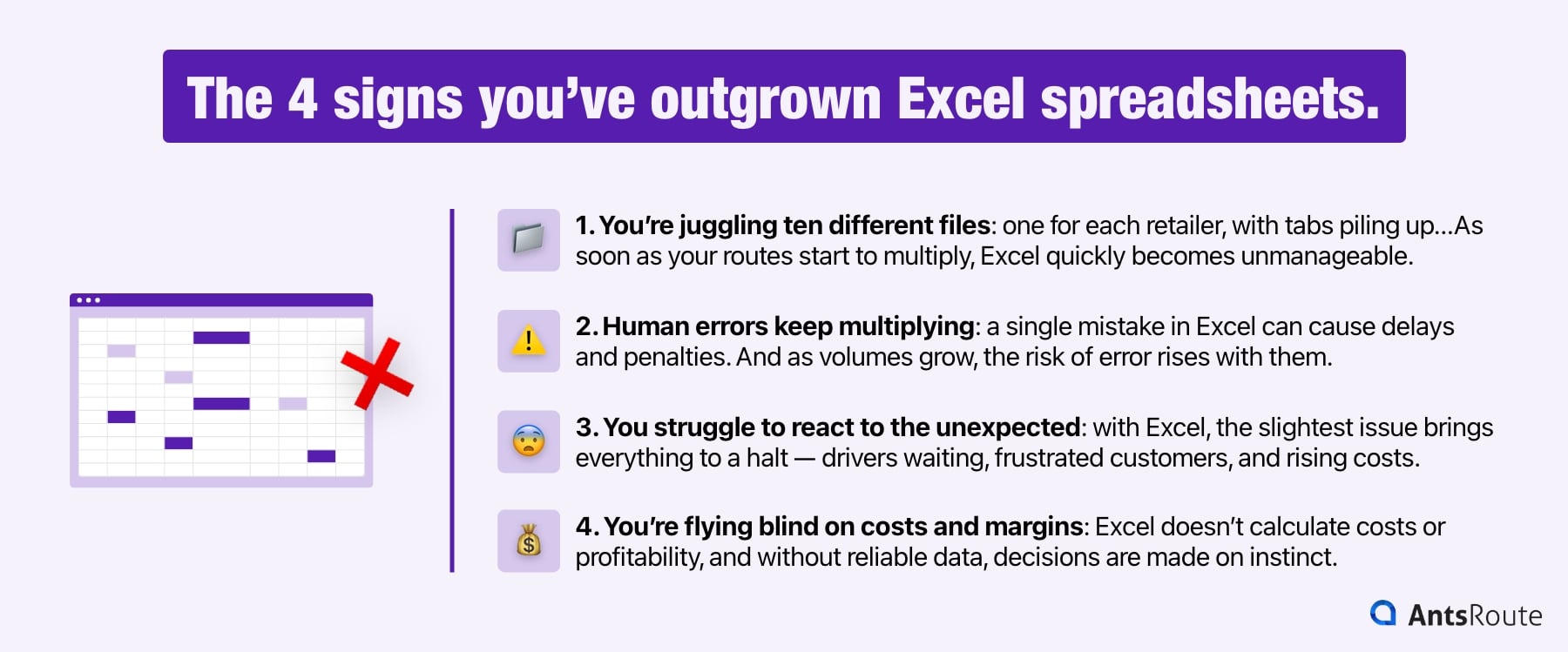
The 4 signs you’ve outgrown Excel.
Automate to regain control of your schedules
Automating doesn’t mean losing control. It means taking it back. In a business where unexpected events happen every day, route optimization software like AntsRoute helps carriers move from reactive organization to smooth, proactive planning. In a previous article, several carriers delivering for Leroy Merlin explained how AntsRoute helped them reduce errors, plan faster, and save several hours each day.
Optimized routes in just a few clicks
No more Excel formulas or endless spreadsheets. AntsRoute automatically assigns each delivery to the right driver, taking into account all your operational constraints: delivery areas, customer time windows, vehicle capacities, specific skills, and even the type of service.
☝️ Example: A customer has chosen a “Delivery + installation” service? Thanks to the Type of service feature, the software automatically assigns the job to a driver trained in installation and adjusts the task duration accordingly.
For more complex operations, AntsRoute offers a Pickup & Delivery feature that manages loading steps across multiple warehouses or retailers, while respecting each vehicle’s capacity. The result: optimized routes, balanced workloads, and zero overloading. Not bad, right?
“Using the software has also improved load distribution across trucks, which has significantly reduced loading issues.” — Bryan Vanderghoote, La Brigade des Transports.
From the very first planning stage, AntsRoute takes into account all the variables that Excel often overlooks, such as capacity, density, installation constraints, and more, to prevent errors right from the start.
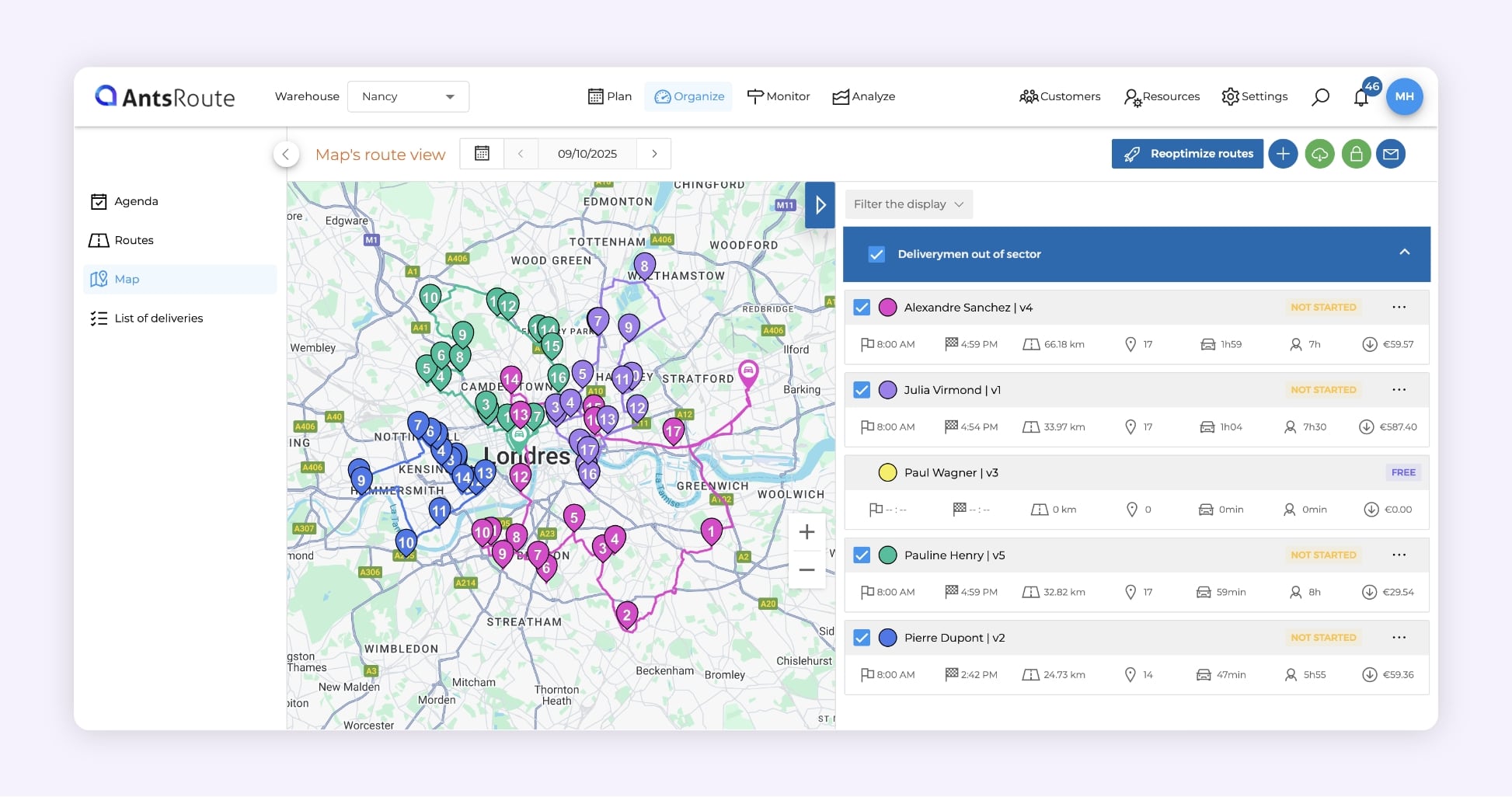
The AntsRoute route optimization software.
Fast, error-free planning
Before AntsRoute, dispatchers spent hours checking, correcting, and rebuilding their routes manually. Now, everything is done in just a few minutes.
“Thanks to AntsRoute’s advanced mapping, I can schedule routes in only 5 minutes, compared to 1 to 2 hours before.” – Rukundo Innocent, Rukundo Trans
The algorithm automatically corrects incorrect addresses or postal codes, one of Excel’s classic pitfalls.
Instant adjustments in case of unexpected events
A truck running late? A customer not home? A last-minute urgent order? With Excel, it’s chaos. With AntsRoute, your route is automatically reorganized in just a few seconds. Your drivers receive real-time updates on their mobile app, and your customers are instantly notified.
“Automatic notifications, along with photos, customer details, signatures, and optional comments, ensure complete transparency. Leroy Merlin and their end customers can track the status of their deliveries in real time.” Franck Dalet, Transport Dalet
And to take it a step further, the AntsRoute booking portal allows your customers to choose their delivery time slot online. If something unexpected happens, they automatically receive a link to confirm or reschedule their delivery. The result: fewer missed appointments, fewer phone calls, and a smoother customer experience.
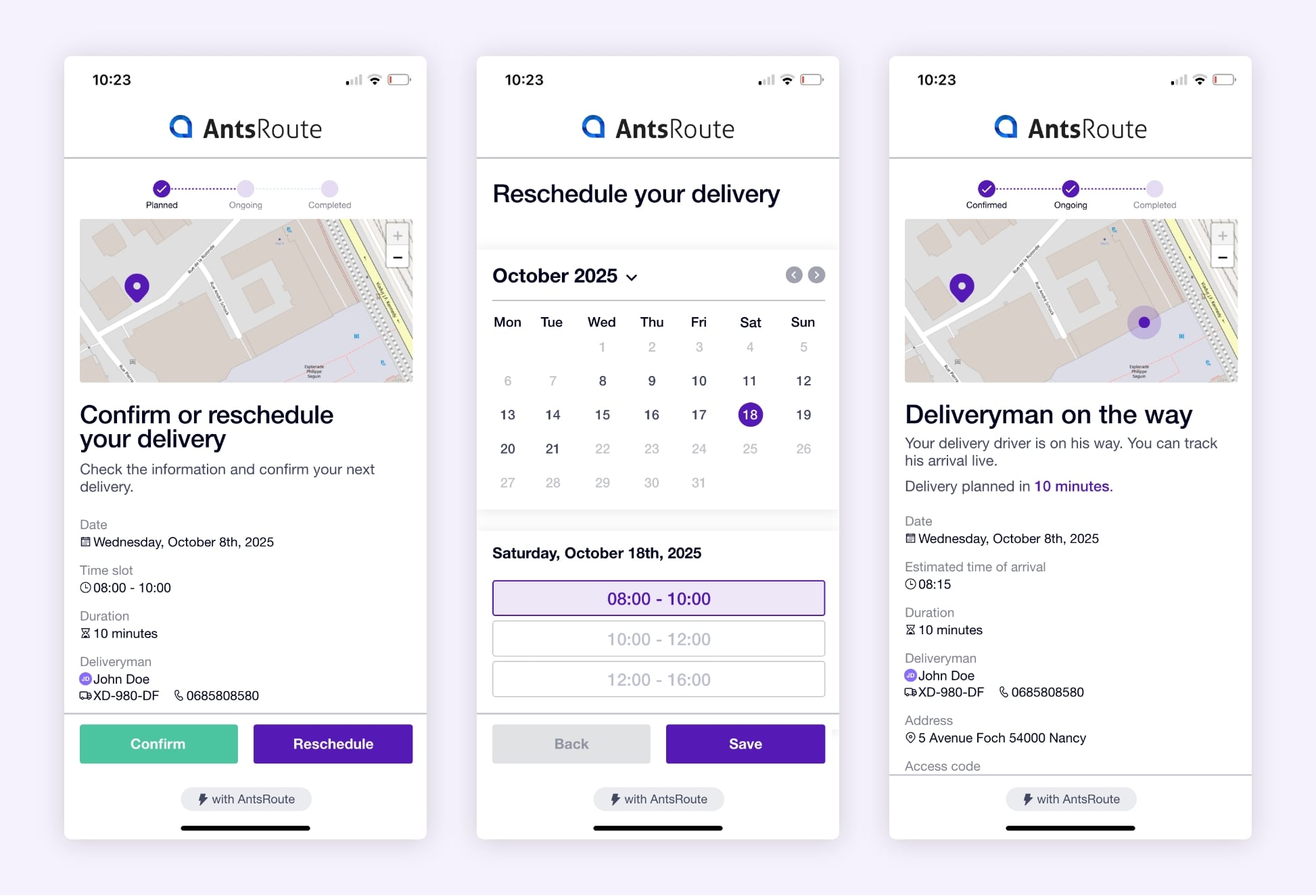
Rescheduling link and delivery tracking sent via AntsRoute.
Data to manage, not just to plan
With AntsRoute, planning goes beyond route optimization. It becomes a true management tool. The software automatically calculates your costs per route, total distance traveled, profitability per retailer, and driver workload.
“With AntsRoute, we can analyze fuel consumption, kilometers driven, failed deliveries, store-by-store statistics, delivered weights and floors, and completed billings. This information allows us to anticipate demand during peak seasons and improve how we manage our operations.” – Raphaël Blandin, Transport Freeman
Thanks to the automatic cost calculation system, you can track your margins by retailer and accurately invoice your partners.
The dashboards bring together all your key KPIs: success rate, delivery volume, kilometers driven, waiting time, fuel consumption, and team productivity. At a glance, you get a complete, data-driven view of your performance.
From Excel to a SaaS solution like AntsRoute: a simple and natural transition
Don’t worry: leaving Excel doesn’t mean starting from scratch. Carriers who digitalize their planning quickly realize they can make the switch smoothly, without disrupting their operations.
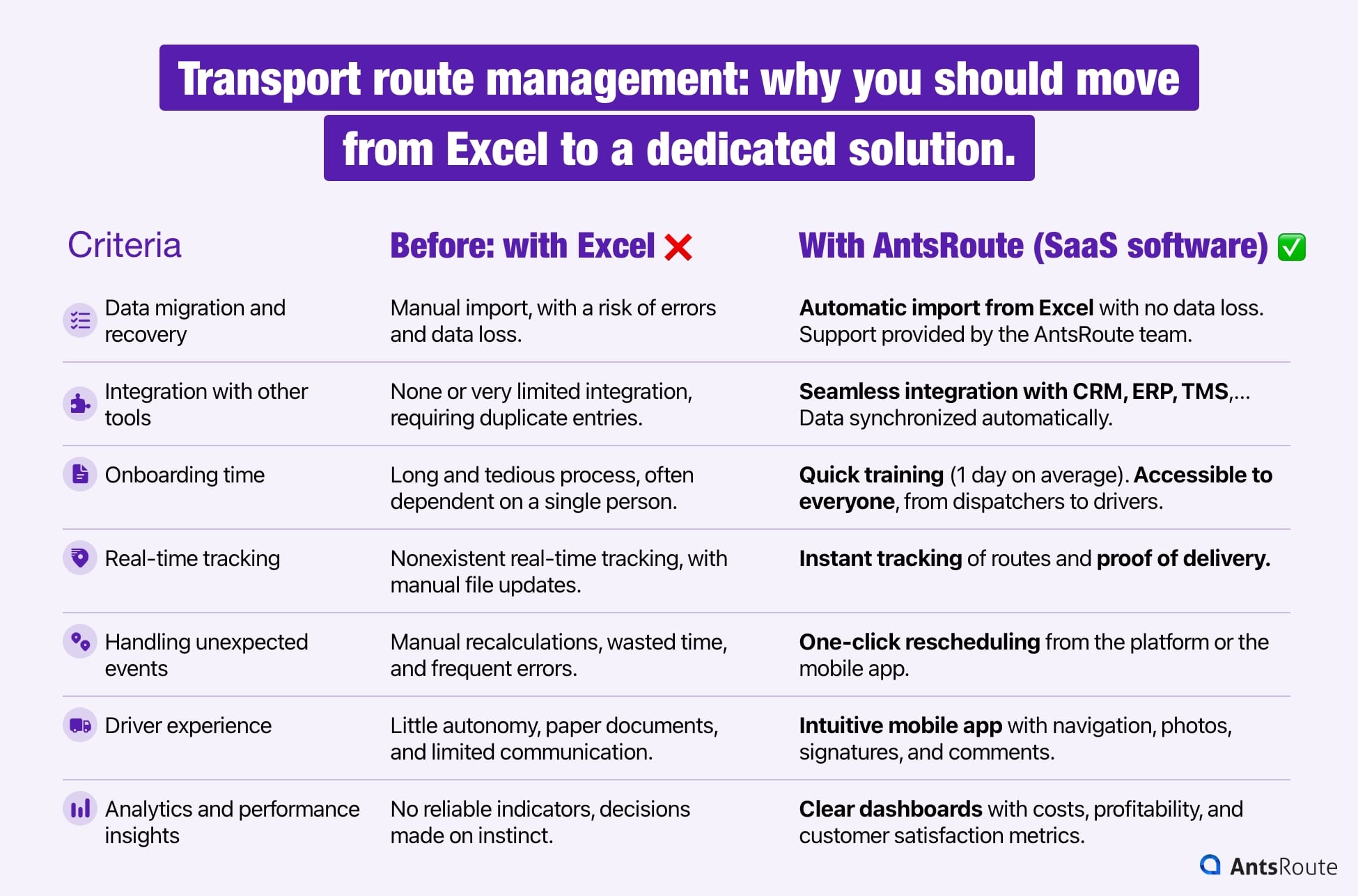
Transport route management: why switch from Excel to a dedicated solution.
A simple, data-safe migration
Your Excel files are not lost. In fact, quite the opposite. AntsRoute uses them to automatically import your existing data: customers, addresses, time slots, service types, vehicles, and more. In just a few clicks, your information comes to life in a clear and intuitive interface that is much easier to read than any spreadsheet.
☝️ Good to know: The AntsRoute team supports you through the import and setup of your data. No technical skills are required.
Seamless integration with your business tools
To make the transition even easier, AntsRoute integrates seamlessly with your existing tools such as CRM, ERP, TMS, or any other business software. Information flows automatically between systems with no double entry and no risk of error. This saves you time, improves reliability, and gives you a unified view of your operations.
Quick onboarding for all your teams
One of AntsRoute’s main strengths is its ease of use. The interface is designed for both dispatchers and drivers, and in most cases, it takes just one day to get fully comfortable with the platform.
In the field, the mobile app guides your drivers throughout their route with navigation, step validation, photo capture, signatures, comments, and rescheduling in case of unexpected events. In the control center, managers can view delivery statuses and proof of delivery in real time.
Visible results from the very first weeks
As soon as the system is up and running, the benefits are concrete and measurable. Carriers quickly notice:
- A reduction in planning time.
- Fewer kilometers driven thanks to route optimization.
- Better workload distribution among drivers.
- A significant increase in customer satisfaction thanks to more reliable routes and automatic notifications.
In just a few weeks, planning stops being a constraint and becomes a performance driver for the entire team.
Switching from Excel to AntsRoute is not a big leap into the unknown. It is a gradual, fully supported transition that turns manual planning into smart management. And in most cases, the return on investment can be measured within just a few weeks. As Bryan Vanderghoote from La Brigade des Transports puts it, “Today, I couldn’t do without it.” So why wait? Try AntsRoute free for 7 days and see for yourself how simple, smooth, and profitable route planning can be.
➡️ Request a free AntsRoute demo
➡️ Check our pricing
FAQ – What if I’m not ready to leave Excel yet?
Yes. AntsRoute makes it easy to import and export your files in just a few clicks and to set up your routes automatically. You stay in control of your data, without disrupting your usual way of working.
No. AntsRoute is designed for dispatchers, not developers. The interface is intuitive, and onboarding support is included.
No problem. Routes are automatically updated when something unexpected happens, and customers receive a notification or a link to reschedule their delivery on their own.
Most companies notice productivity gains within the first few weeks.
Yes, and that’s actually one of its main strengths. The software manages the specific constraints of multiple retailers, such as delivery areas, time windows, warehouses, and service types, and automatically calculates route costs for clear and accurate billing.
WRITTEN BY

Florine Martin
Florine has been a freelance web copywriter since 2021, writing for a variety of clients in a range of sectors. Since the beginning of 2024, she has been writing articles about logistics for our company, AntsRoute.
Free 7-day trial | No credit card required
Contenu
- The promises of Excel (and why they no longer deliver)
- Promise #1: “It’s free and flexible.”
- Promise #2: “I stay in control of my schedules.”
- Promise #3: “It’s easy to update.”
- The 4 signs you’ve outgrown spreadsheets
- 1. You’re juggling ten different files
- 2. Human errors are piling up
- 3. You struggle to react to the unexpected
- 4. You’re flying blind when it comes to costs and margins
- Automate to regain control of your schedules
- Optimized routes in just a few clicks
- Fast, error-free planning
- Instant adjustments in case of unexpected events
- Data to manage, not just to plan
- From Excel to a SaaS solution like AntsRoute: a simple and natural transition
- A simple, data-safe migration
- Seamless integration with your business tools
- Quick onboarding for all your teams
- Visible results from the very first weeks
- FAQ – What if I’m not ready to leave Excel yet?

